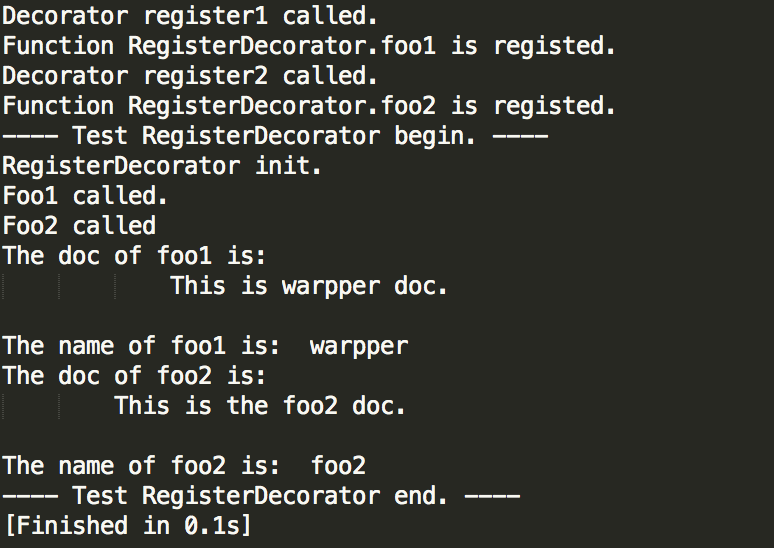最近打算重新开始记录自己的学习过程,于是就捡起被自己废弃了一年多的博客。这篇学习笔记主要是记录近来看的有关Python装饰器的东西。
0. 什么是装饰器?
本质上来说,装饰器其实就是一个特殊功能的函数,这个特殊的功能就是:装饰另一个函数。举一个最简单的例子来说:
1 def identify(f): 2 print 'Decorator identify called.' 3 return f
这里identify其实是一个装饰器,这个装饰器对输入的参数f不进行任何修饰,然后返回这个参数。其中的打印语句是用来判断这个装饰器是什么时候被调用的。接下去,我们可以这样用这个装饰器:
1 @identify 2 def foo(): 3 print 'foo called.'
装饰器的语法是以@开头,然后跟着装饰器函数的名字,然后一些可选的装饰器函数的参数。紧跟着是被修饰的函数的定义。上述带装饰器的函数定义可以看成以下语法糖:
1 def foo(): 2 print 'foo called.' 3 foo = identify(foo)
写一个简单的类来对上述例子做一下测试:
1 # Decorators 2 def identify(f): 3 print 'Decorator identify called.' 4 return f 5 class SimpleDecorator(object): 6 """ 7 This is my first decorator test class. 8 """ 9 10 def __init__(self): 11 super(SimpleDecorator, self).__init__() 12 print 'SimpleDecorator init.' 13 14 @identify 15 def foo(self): 16 print 'Foo called.' 17 18 def test(self): 19 self.foo() 20 if __name__ == '__main__': 21 print '---- Test SimpleDecorator begin. ----' 22 simpleDecorator = SimpleDecorator() 23 simpleDecorator.test() 24 print '---- Test SimpleDecorator end. ----'
为了简单起见,我这里没有把identify装饰器写成类静态方法,因为类静态方法的定义也是利用装饰器来的。运行上述的测试代码,得到如下的输出:

可以看到装饰器函数比类实例的初始化还早,这说明在利用装饰器定义foo函数的时候装饰器函数已经被调用了。
1. 注册函数的装饰器。
接下去,我们来定义一个稍微复杂一点的装饰器,这个装饰器能把被装饰的函数注册到一个全局的字典里面。
1 _functions = {} 2 def register1(class_name): 3 def _register(f): 4 """ 5 This is register1 doc. 6 """ 7 print 'Decorator register1 called.' 8 global _functions 9 name = class_name + '.' + f.__name__ 10 _functions[name] = f 11 print 'Function %s is registed.' % name 12 def warpper(*args, **kwargs): 13 """ 14 This is warpper doc. 15 """ 16 f(*args, **kwargs) 17 return warpper 18 return _register
首先,这是一个带参数的装饰器。我们可以先看看怎么用这个装饰器,
@register1('RegisterDecorator') def foo1(): """ This is the foo1 doc. """ print 'Foo1 called.'
接下去,结合装饰器的定义来分析一下上述的代码。首先对于这句定义 @register1('RegisterDecorator')可以理解成@(register1('RegisterDecorator'))这样的优先级,也就是我们先传入参数'RegisterDecorator'来调用register1函数,可以看到register1函数其实是返回一个_register函数,在这里我更愿意把_register看成真正的装饰器。所以这句定义@register1('RegisterDecorator')就可以看成@_register,而这个_register其实是定义在带有参数'RegisterDecorator'信息的作用域内部。接下去的@_register就跟不带参数的装饰器一样了,所以在定义foo1函数的时候_register函数会被调用,在这个函数内部,foo1会被注册在一个全局的字典内部,然后返回一个跟foo1一样功能的函数。
2.functools装饰器工具
我们在来深入讨论一下上述装饰器,上述装饰器虽然达到我们注册函数的装饰作用,但是其实你会发现,这个被装饰的函数foo1已经不是原来的foo1,比如foo1.__doc__和foo1.__name__已经不是原来foo1时的"This is the foo1 doc"和"foo1"。这是怎么回事呢?因为装饰器其实只是一个语法糖,被装饰的foo1其实等于_register里面返回的wrapper函数,也就是foo1 = _register(foo1),而_register返回的正是wrapper函数,所以此时的foo1.__doc__和foo1.__name__应该是"This is wrapper doc."和"wrapper"。那么要如何避免上述的情况的呢,那就是利用装饰器工具functools。其实functools也是提供一些装饰器,这个装饰器可以保证你在定义装饰器时保留原来函数的__doc__和__name__属性。具体例子如下:
1 import functools
3 4 5 _functions = {} 6 def register1(class_name): 7 def _register(f): 8 """ 9 This is register1 doc. 10 """ 11 print 'Decorator register1 called.' 12 global _functions 13 name = class_name + '.' + f.__name__ 14 _functions[name] = f 15 print 'Function %s is registed.' % name 16 def warpper(*args, **kwargs): 17 """ 18 This is warpper doc. 19 """ 20 f(*args, **kwargs) 21 return warpper 22 return _register 23 24 25 def register2(class_name): 26 def _register(f): 27 """ 28 This is register2 doc. 29 """ 30 print 'Decorator register2 called.' 31 global _functions 32 name = class_name + '.' + f.__name__ 33 _functions[name] = f 34 print 'Function %s is registed.' % name 35 @functools.wraps(f) 36 def warpper(*args, **kwargs): 37 """ 38 This is warpper doc. 39 """ 40 f(*args, **kwargs) 41 return warpper 42 return _register 43 44 class RegisterDecorator(object): 45 """ 46 This is register Decorator. 47 The decorator registed the function in golbal dict. 48 """ 49 50 def __init__(self): 51 super(RegisterDecorator, self).__init__() 52 print 'RegisterDecorator init.' 53 54 @register1('RegisterDecorator') 55 def foo1(self): 56 """ 57 This is the foo1 doc. 58 """ 59 print 'Foo1 called.' 60 61 @register2('RegisterDecorator') 62 def foo2(self): 63 """ 64 This is the foo2 doc. 65 """ 66 print 'Foo2 called' 67 68 def test(self): 69 self.foo1() 70 self.foo2() 71 pass 72 73 if __name__ == '__main__': 74 print '---- Test RegisterDecorator begin. ----' 75 registerDecorator = RegisterDecorator() 76 registerDecorator.test() 77 print 'The doc of foo1 is: ', registerDecorator.foo1.__doc__ 78 print 'The name of foo1 is: ', registerDecorator.foo1.__name__ 79 print 'The doc of foo2 is: ', registerDecorator.foo2.__doc__ 80 print 'The name of foo2 is: ', registerDecorator.foo2.__name__ 81 print '---- Test RegisterDecorator end. ----'
register2和register1唯一不同的是,regisrer2返回的是被装饰器 @functools.wraps 装饰过的warpper函数。上述测试代码的输出为:

关于上述的测试代码托管在github上:https://github.com/fengzaihou/PythonLearning/tree/master/Decorators



